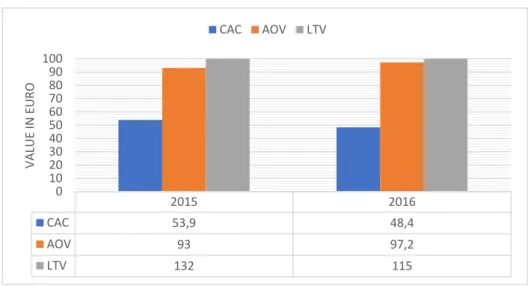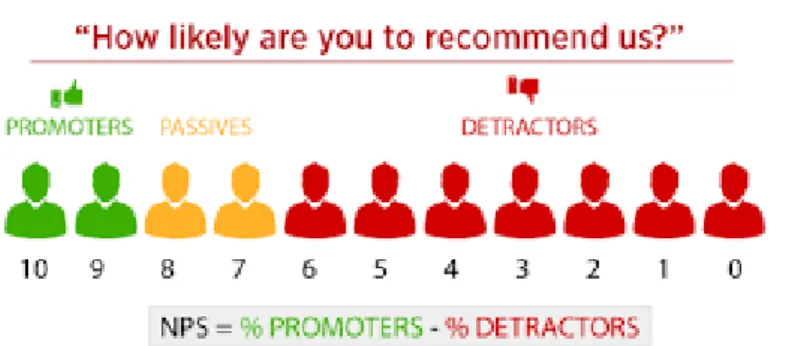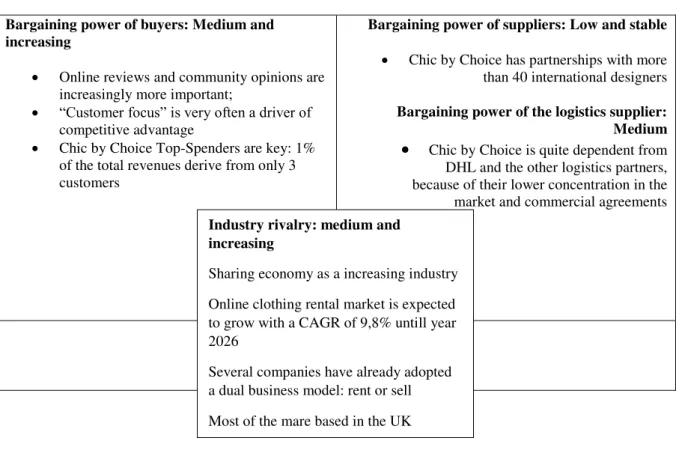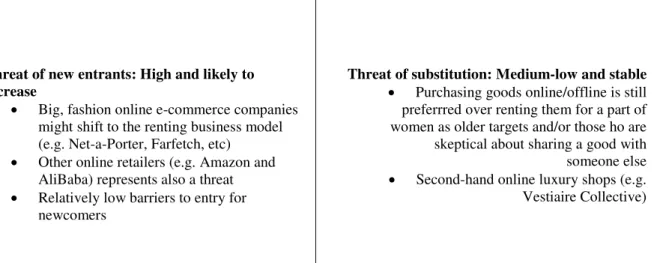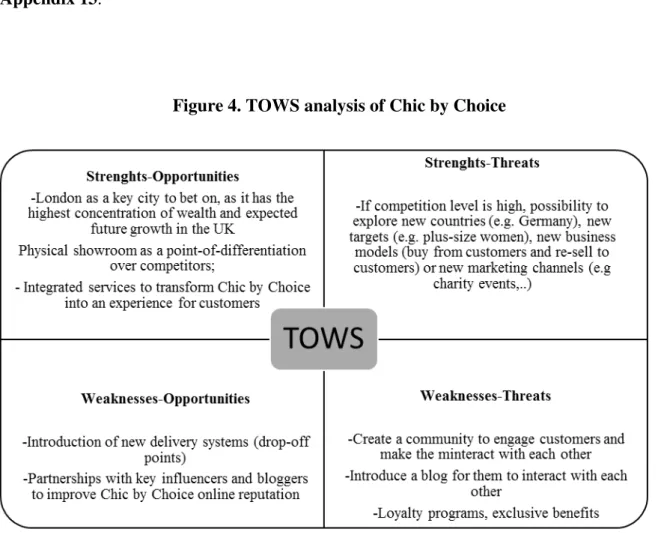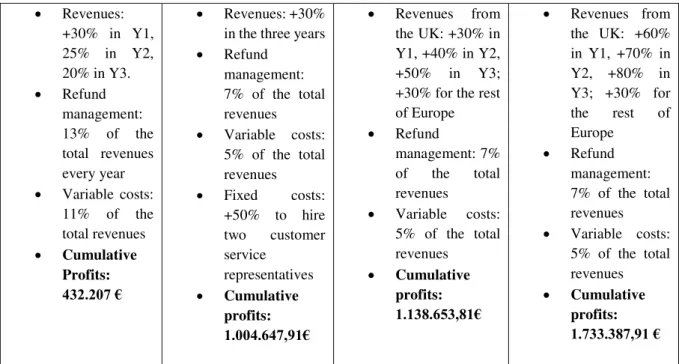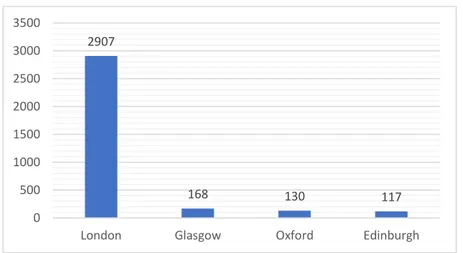1
A Work Project, presented as part of the requirements for the Award of a Master Degree in Management from the NOVA – School of Business and Economics
Key customers retention as a company
’
s competitive
advantage: Chic by Choice case study
GAIA VILLATORA MILIČ
#3051
A project carried out on the Master in Management Program, under the
supervision of Professor Leid Zejnilovic
2 Abstract
Chic by Choice, Portuguese company founded in 2014, is one of the leading dress-rental
businesses in Europe. Lately, however, many customers have complained for the bad service.
After analyzing the main reasons for customers’ dissatisfaction, I first propose a set of solutions to limit the damages for an online business. Secondly, I define and compare four different
scenarios, arguing that an internationalization strategy in the United Kingdom will enable Chic
by Choice to gain sustainable competitive advantage. Finally, I conduct an Area Analysis to
select the location that will maximize the company’s future profits.
Keywords: e-Commerce, Chic by Choice, Operations Management, Customer retention
Acknowledgements
I would like to sincerely thank you Lara Vidreiro and Filipa Neto, founders of Chic by Choice
and inspiring women, because they welcomed me in their company and they believe in me.
Also, I am grateful to all the Chic by Choice Team, to be always supportive. I would like then
to express my gratitude to professor Leid Zejnilovic, that pushed me to do my best and for being
helpful anytime I needed his feedback. Thank you to the Nova Masters Office whole school
staff to prepare all students for a brilliant career. But, above all, thank you to my mum and my
family, that supported me every single moment of my life, without you all this could not have
3 Table of contents
Introduction ... 4
Methodology ... 4
Literature Review ... 4
Sharing economy ... 5
Logistics challenges in shared economy services designed for the global market ... 6
Internal Analysis ... 7
Overview of Chic by Choice ... 7
Strategic Objectives ... 8
Main KPI’s and data analysis ... 9
External Analysis ... 12
Market overview ... 12
The UK market ... 14
Competitive landscape ... 15
Porter’s five forces model ... 15-16 SWOT analysis ... 16
TOWS analysis ... 17
Identifying and responding to the challenges of serving an international market ... 17
Phase 1: Improving the logistic to increase the service level ... 18
Phase 2: Retaining and engaging the most profitable customers ... 19
Strategic and operational changes ... 19
Internationalization strategy ... 19
Comparing four different scenarios: Cost/Benefit Analysis ... 20
UK Entry Mode ... 21
Area Analysis ... 22
Final Recommendations and conclusions ... 24
List of references ... 26
4 Introduction
The sharing economy phenomenon has rapidly increased since years 2010’s becoming one of the most profitable industries. Several new businesses spread based on the concept of
“collaborative consumption”, where consumers dispose of goods and services instead of
purchasing them. Chic by Choice, luxury dress rental company founded in 2014, belongs to this
industry and indeed, it has grown since then. As an e-commerce retailer, the expansion in all
the European countries was quite rapid, however, the increasing number of international
customers has generated logistics issues and challenges. As a consequence, customers tend to
complain online, affecting Chic by Choice reliability, which is mining the company’s strategic objectives to double the profits by 2020. Keeping in mind that online reviews are nowadays
essential for companies, external and internal data were analyzed to assess the potential of Chic
by Choice main markets and define a future strategy to gain competitive advantage. For this
purpose, four different scenarios were defined and compared between each other with a
Cost/Benefit Analysis. Also, a key target was identified, and, in order to deliver the best
customer value, Chic by Choice should consider moving the logistics in the UK and integrated
offline channels of communication to the current marketing strategy. Today, omni-channel
marketing strategies are increasingly adopted by companies, as it enables to engage customers
in every touchpoint. To conclude, an Area Analysis was conducted with the Critical Success
Factors method, as the location choice can be part of a company’s competitive advantage.
Methodology
To collect information relevant for the analysis, both primary and secondary data were utilized.
5
service / logistics support intern; Interviews with Chic by Choice Team, including the two
founders Lara Vidreiro and Filipa Neto, were a valuable source of information. Secondary data
include CRM tools such as Zendesk and NPS (the Net Promoter Score); analytical tools like
KissMetrics, Google Analytics and company’s databases, such as Google spreadsheets and
Microsoft Power BI. Other sources were articles, textbooks, business journals and blogs;
Passport Euromonitor and other updated statistics taken from management consulting firms
reports (Deloitte, PwC). Based on the set of data collected, some useful models were used
(SWOT/TOWS analysis, Porter’s 5 Forces) in order to outline four different scenarios. To select
the most profitable one, a Cost/Benefit Analysis based on three years forecast (2017-2019) was
conducted. In the final part of the thesis, the Critical Success Factors method was implemented
as part of the Area analysis, in order to maximize Chic by Choice’s future growth.
Literature review
Sharing economy
As described by Alex Stephany (2015), companies operating in the sharing economy industry
can follow two business models: B2C, where a company owns the stock and the platform to
sell products and or services to final customers; and P2P, peer-to-peer, where the members of
the community interact and conclude the transaction themselves. Chic by Choice clearly
follows the first business model, while companies like Uber or Airbnb are based on a
community. However, the author identifies four common factors of the sharing economy,
6
each other; Finally, convenience, because users are reduced the need of ownership and are charged only for what they dispose of (Stephany 2015). However, as pointed out by Jennifer
Hyman in the article “Will the sharing economy work for fashion?”, a fashion rental company
might face several logistics barriers related to transportation, stock management, repairs and
dry cleaning, all factors that increase the costs for a company. Logistics is instrumental for a
sharing economy business, as customers have increasingly high expectations about home
delivery. As demonstrated by Xing, Grant, McKinnon, and Fernie (2011), there are four main
variables valued by customers when waiting for a home delivery: Timeliness, Availability,
Condition, Return. [Appendix 1].
Logistics challenges in shared economy services designed for the global market
A “frictionless delivery experience”, is what customers expect from luxury online retailers, as
defined by Cohen Raanan, (2016). Logistics and operations are aimed at supporting the overall
strategy and value proposition of a company, and must be consequently aligned with the needs
of a specific target (Simchi-Levi, 2010).
Generally, a company can choose the location under two different perspectives, namely cost focus or revenue focus (Heizer and Render, 2004). Typically, the former is preferred by industrial companies, as it is enables to contain costs, while the latter by a service company or
retailer, as the area is selected to increase sales and revenues.
Several other factors should be taken into account by a service company or retailer when
evaluating an area: customers’ demographics, proximity of competitors, income taxes, traffic counts, transportation system to name just a few.
A diffused method to select a location is the “Factor- Rating” method, that considers both tangible (quantitative) and intangible (qualitative) Critical Success Factors, that are each
7
values are multiplied and the location with the highest total is considered the best one. Such a
method will be used later in this paper for assessing the attractiveness of four neighborhoods.
Therefore, the operational part is a crucial aspect for a company, and strategic decisions - such
as location choice - should be carefully evaluated by a company, as it affects future costs and
profits. Attracting, retaining and engaging profitable targets is now more important than ever,
as customer satisfaction can be the main driver for the competitive advantage of a firm.
According to a recent article by by Sara Judd Welch (2014), for instance, it is explained that
customer retention can be 80% less costly than new customers acquisition and that an increase
in customer retention by only 5% can lead to an increase of profitability of up to 95% in the
long term. Lastly, it is important to bear in mind that the Internet and Social Media represent a
catalyst of a customer’s experience with a service or a product, as reviews are easily spread online, and have a dramatic impact on a company’s reputation. Dellarocas (2003) and Henning-Thurrau (2004), define online reviews as more accessible and for longer than the word-of
mouth. Additionally, Nielsen, Dimensional Research and BrightLocal (2002, 2003, 2004,
respectively) have found out that more than 70% of the people that buy online trust ratings and
reviews from other customers.
Internal analysis
Overview of Chic by Choice
Chic by Choice is considered one of the best European online fashion startups. Founded in year
2014 by Lara Vidreiro and Filipa Neto, it is an e-commerce retailer that allows to rent luxury
designer dresses for 4 or 8 days, with prices up to 90% lower than the retail price. The mission
of the company is to make feel every women self-confident and beautiful, by wearing fabulous
dresses with economic consciousness. Every season, new dresses are added to the Lisbon
8
The idea of the two young founders was supported since the beginning by Startup Lisboa,
incubator for local startups in Lisbon. Very quickly, the startup attracted seeds fundings from
Faber Ventures, Portugal Ventures, Edge Group and Portuguese Venture Capitalist Group. In
its early stage, Chic by Choice grew at a rate of around 30% per month. The expansion to other
markets accelerated in 2014, when they acquired one of their main competitors, Wish Want Wear from the UK. In August 2015, they also acquired La Remia, a fashion rental company from Berlin.
Currently, Chic by Choice operates in 15 European countries, with UK, Germany and Portugal
representing the main markets. The total number of online visitors during the year 2016 was
almost of 1 million, and out of this, the number of registered users from all over Europe was of
84,976 (9,44%). [Appendix 2]In May of 2016 the company introduced also the accessories rental, and it created a physical showroom in Lisbon that led to an increase of the reservations
of more than 50%. Recently, Chic by Choice launched an App for mobile devices such as
smartphones and tablets.
Chic by Choice is following the increasing trend of the sharing economy, an industry increasing year by year, and expected to further grow in the next decade, reaching sales up 335 billion $,
out of which 15 billion $ will be generated in the UK only, as estimated by a recent study by
PwC.
Strategic objectives
Chic by Choice wants to double its profits in three years, raising the repeated purchase rate
customers from the current average of 25,6% to 50%. To be successful in pursuing this goal, it
is first important to increase the overall customers’ satisfaction by lowering the percentage of
9
European market leader in the dress rental industry by 2020, bad ratings might represent an
obstacle to attract and retain potential customers, influenced by negative reviews.
Main KPI’s and data analysis
The dress rental business is growing, as the total number of reservation in the last year grew
59% in terms of reservations volume (4137 reservations in 2016 compared to 2607 reservations
in 2015), and of 28% in terms of total revenues from 2015 to 2016. [Appendix 3]
The percentage of repeat purchase customers in the three biggest markets are on average of
22% in Germany (18% in 2015); 18% in Portugal (15% in 2015) and 24% in the UK, (16% in
2015). [Appendix 4]
Yet, other KPI’s indicate that there are factors potentially undermining the company’s profitability in the long run. One of the most important KPI’s in an online business is the Cost
of Acquisition1, that reveals how much economic effort is needed in order to acquire new
customers. However, this value iself does not reveal the health of a business, as it must be
compared to other KPI’s as the Average Order Value (AOV), that measures the average order
placed by customers in a defined period of time. The higher the Cost of Acquisition (CAC)
compared to the Average Order Value (AOV), the lower is a company’s margin. From Chic by Choice financial reports, we can see that the CAC in 2015 was on average 58% of the AOV,
while in 2016 the average CAC is 50% (see appendix for further details), being the paid Search
(GoogleAd, Bing) and Facebook the main drivers of the total Cost of Acquisition. Another
1
10
important KPI’s is the Customer Life Time Value (LTV)2, which is an estimate of the future
streams of profits generated by each customer. According to a common benchmark used in the
marketing industry (as suggested on KissMetrics3), if the ratio LTV:CAC is lower or equal to
1, the business is shrinking; On the other hand, if the ratio is above 4, the company is probably
underinvesting in retaining customers. The ideal ratio is of about 3:1. In the period January -
June 2016, the average LTV for Chic by Choice is of 115 € and the CAC was of 48,4 € resulting
in a ratio of 2,37, very close to the ideal condition. The following table summarizes the main
KPI’s for Chic by Choice in the years 2015- 2016:
Figure 1. Main KPI’s are compared between 2015 and 2016: Cost of Acquisition, Average Order Value, Customer Life Time Value
The KPI’s considered until now suggest that Chic by Choice is overall a healthy business. However, the forecasted growth of the sharing economy industry and the dress rental market
will certainly increase the level of competition in the near future. This thesis is aiming therefore
2 , or
where ARPA stands for “Average Revenue Per Account”. “Customer Churn Rate” is defined as the percentage of registered users who unsuscribe the service in a specific time interval. Source: Kiss Metrics Blog
3 Source: https://blog.kissmetrics.com/bigger-marketing-budget/
2015 2016
CAC 53,9 48,4
AOV 93 97,2
LTV 132 115
0 10 20 30 40 50 60 70 80 90 100 V A LUE IN E URO
11
to define a strategy for providing a better service to respond to an increasing number of
customers and ultimately retain the strategic, most profitable segment, as it can represent a
company’s competitive advantage.
Although the main marketing KPI’s suggest that Chic by Choice is a healthy business, several
customers complain about a bad experience. [Appendix 5] The data were retrieved from the Internet, Zendesk and NPS statistic.
Net Promoter Score (NPS), a common metric that measures customers’s satisfaction, is today a powerful tool for companies, as it can suggest the probability of future growth. Customers are
asked how likely they are to recommend the service or product to their friends from 0 (“Not likely”) to 10 (“Extremely likely”), hence classified in “Dectractors” if they score between 0 and 6, “Passive” if they score between 7 and 8 or “Promoters” if they score 9 or 10. Having a
relevant percentage of Promoters is almost vital for companies, as they spread a good opinion
about their experience, hence they can enhance growth of a company4.
Figure 2. Net Promoter Score (NPS)
The NPS varies day by day. In the case of Chic by Choice, at the beginning of October there
were 36% promoters and 16% detractors. On 31st of December, only 36% of the customers
were promoters and 51% were detractors. Most of the complaints from the detractors were
12
regarding delivery issues, or receiving a wrong dress or an item of an inferior quality than
expected. Bad reviews are also easily found online.
Zendesk reviews were analysed to gain deeper knowledge about the problem. Zendesk is
platform for Customer Relationship Management (CRM) that facilitates communication and
support to clients, with live chat and instant messaging. At the same time, it also allows to
collect and analyse important data and statistics on interactions with customers.
The most frequent complaints on Zendesk were: (i) not receiving a refund (15 %); (ii) not
receiving the parcel on time or at all (7%); (iii) receiving no answer from the Customer Service
Team (7%); and, (iv) receiving a wrong dress / not fitting one / or being disappointed by its
quality (6%). [Appendix 6]
Obviously, the refund request is the consequence of most of the factors mentioned above.
Currently, the value of refunds amounts to 31% of the total revenues, three times higher than
the relative value in 2015 (11%). [Appendix 7] In the long run, the growing discontent not only affects the cost side, but, also the company’s reputation and credibility. Hence, it is instrumental to improve the service and increase the percentage of satisfied customers.
External Analysis Market overview
13
Figure 5. Volume of reservations of the three markets for years 2015 and 2016.
United Kingdom represents the major market, Consequently, more than than 50% of the total
revenues originate from the UK market, even though the growth of rate of sales is higher in
other countries [Appendix 8].
In order to continue the analysis, some external data on these three markets were collected.
First, it is true that Portugal is the second market in terms of volume and value, however UK
and Germany can be more attractive markets for several reasons. First, they have a higher
population: 65,246,001 inhabitants5 – among which 8,3 million inhabitants for the city of London - and 80,679,211 respectively, against the 10,282,000 in Portugal6. Second, these two
countries have a higher purchasing power than Portugal; UK, in particular, has experienced the
highest discretionary spending in Europe in year 2015. This is in a way reflected by the fact
that the AOV of Chic by Choice customers from Portugal is of 77,6 €, while it is of 108,4€ for customers from the UK and 93,6 € for German customers. Third, the online shopping
5 On the date 03/11/2016, source: www.worldometers.info/world-population/uk-population/
6 On the date 03/11/2016, source: http://www.worldometers.info/world-population/portugal-population/ 297
1977
218 1004
2298
610
0 1000 2000 3000
Portugal United Kingdom Germany
Total number of reservations of
the three main markets: UK,
Germany and Portugal
14
penetration in 2015 was of 77% in the UK, being the highest in Europe, followed by 65.5%
registered in Germany and about 60% in Portugal7.
Regarding the number of Chic by Choice new subscribers, this was of 78.260 from the United
Kingdom, 4175 from Portugal, 1563 from Germany and 978 from the rest of Europe. It must
also be mentioned that the Top-20 spenders in absolute terms are all from the UK [Appendix 9]. Based on the data discussed, and given the strategic goal of doubling the revenue, it may be worthwhile to explore how to improve operations in the UK market. Also, the company
explicitly requested developing a strategic analysis aiming to improve the logistics in this
market. To further verify the country attractiveness, an external analysis follows.
The UK market
The UK is one of the leading countries in the world for online shopping: more than 77% of the
total internet users in the UK purchased goods online in 2015, spending on average 3,652 €
each8. Forecasts on e-commerce industry suggest that in the UK it will further increase until
2019 [Appendix 10]. The most popular product categories are respectively clothing, books and home appliances9. What might be of interest for Chic by Choice is that the UK population is
highly interested in luxury online retailers. A recent study by Simone Guercini and Andrea
Runfola (2015) demonstrated that the majority of visitors of luxury multibrand e-commerce
retailers are from the United States (66,49%), followed by South Korea, Japan, and China (4%)
and UK (2,67%).
7 Source: https://www.statista.com/statistics/274251/retail-site-penetration-across-markets/
8 Source: Ecommerce news Europe (April 2016):
https://www.twenga-solutions.com/en/insights/ecommerce-united-kingdom-facts-figures-2016/
15
Other relevant data on the UK demographics taken from Passport Euromonitor show that the
city with the highest concentration of wealth and consumer expenditure is London, which is
expected to further grow in the next decades.
Competitive landscape
In the United Kingdom, Chic by Choice have several direct competitors: Girlsmeetdress.com,
Dreamwardrobe.com, Hirethecatwalk.com, and Mycelebritydress.com (based on Google and
Bing research). As Chic by Choice, they offer a wide selection of dresses, promise the perfect
fit for every customer, and offer promotions for the first rental. Appendix 11 summarizes the primary competitors main features; Secondary main competitors can be considered as luxury
multibrand retailers [Appendix 12].
To illustrate the external forces that define the dress.rental industry (namely, bargaining power
of suppliers, bargaining power of buyers, threat of entrants, threat of substitution) the Porter’s
Five Forces Model follow.
Figure 6. Porter’s Five Forces model
Bargaining power of buyers: Medium and increasing
Online reviews and community opinions are increasingly more important;
“Customer focus” is very often a driver of
competitive advantage
Chic by Choice Top-Spenders are key: 1% of the total revenues derive from only 3 customers
Bargaining power of suppliers: Low and stable
Chic by Choice has partnerships with more than 40 international designers
Bargaining power of the logistics supplier: Medium
Chic by Choice is quite dependent from DHL and the other logistics partners, because of their lower concentration in the market and commercial agreements
Industry rivalry: medium and increasing
Sharing economy as a increasing industry
Online clothing rental market is expected to grow with a CAGR of 9,8% untill year 2026
Several companies have already adopted a dual business model: rent or sell
16
Threat of new entrants: High and likely to increase
Big, fashion online e-commerce companies might shift to the renting business model (e.g. Net-a-Porter, Farfetch, etc)
Other online retailers (e.g. Amazon and AliBaba) represents also a threat
Relatively low barriers to entry for newcomers
Threat of substitution: Medium-low and stable Purchasing goods online/offline is still preferrred over renting them for a part of women as older targets and/or those ho are skeptical about sharing a good with someone else
Second-hand online luxury shops (e.g. Vestiaire Collective)
SWOT ANALYSIS
The following graph summarizes the main strenghts, weaknesses, opportunities and threats of
Chic by Choice in the current status.
Figure 3. SWOT analysis of Chic by Choice
Strenghts
-Wide assortments of dresses for each occasion, new arrivals
-Presence throught all Europe
-Anna Mangold and Claudia von Boeselager, the founders of La Remia, are on board as advisors -Showroom in Lisbon generates a relevant part of
revenues (up to 20% of the Lisbon customers)
Weaknesses
-Inefficient quality management system and complaint management
-Consequently, increasing number of Detractors (48% on the day 30/12/2016)
-Logistics is not fully controlled by Chic by Choice -Relatively high acquisitions costs of new
customers
Opportunities
-Partnerships with non-competing brands for cross-promotions and sales
-UK e-commerce penetration: 77% of the population purchased online in 2015 -Online research for "rent designer clothes" has increased of 120% since 2014, meaning that the
market is growing
Threats
-Increasing number of competitors in the dress-rental market
-Several of them adopting the rent and/or buy option
-Negative ratings and online reviews that can mine Chic by Choice's credibility
17
Moreover, a detailed TOWS analysis is presented below, with the aim of defining possible
strategies for Chic by Choice. The top left section (SO) purpose is to leverage on the current
strenghts to maximize future opportunities; while on the top-right (ST), strenghts are aimed at
minimizing the external threats. On the bottom part, WO (Weaknesses-Opportunities) is useful
to minimize the weaknesses by exploring the opportunities in the market and finally WT aims
at avoiding threats and minimize weaknesses. A detailed PESTLE analysis is presented in
Appendix 13.
Figure 4. TOWS analysis of Chic by Choice
Identifying and responding the challenges of serving an international market Phase 1: Improving the logistic to increase the service level
18
first goal to achieve the company’s growth. Planning the deliveries in advance would increase
the level of efficiency and reduce the risks of an unsuccessful delivery. This would include, for
instance, minor changes to the layout of the customer’s personal page, to review and correct
their data for the shipment; Also, providing an alternative address in case the person is not at
home will be useful. In addition, a quality system should be introduced by Chic by Choice, in
order to guarantee that dresses are in perfect conditions before being delivered to customers.
Finally, categorizing the Zendesk requests and ensuring an answer before three working days
(especially for the refund issue) will improve the customer service experience.
As a matter of fact, customer service representatives play a key role: In a recent survey
conducted by Zendesk participants ranked customer service as the most important factor for a
company’s trust, 95% shared their bad experience and 87% their good experience with others10.
Phase 2: Retain and engage the most profitable customers
It is clear that the UK market is very attractive for Chic by Choice: large population, high
purchasing power associated to e-commerce penetration, and relatively high number of visitors
interested in the Chic by Choice concept. In particular, the most profitable customers, can be
considered as the strategic target to leverage on. As stated by Simchi-Levi David (2010), it is
crucial for the success of a company to identify the most profitable target and to align the value
proposition. In other words, focusing on the selected target, aligning the value proposition,
creating and delivering customer value constitutes a competitive advantage for a company. Chic
by Choice identified as the main target of interest the high spending segment, typically
represented by wealthy women aged between 35 and 50 years old, that place on average
19
between 5-10 reservations per year, and like to be personally assisted by a stylist in the choice
of the dress.
Strategic and operational changes
Internationalization strategy
Given the relevant and increasing level of competition in the UK, Chic by Choice should
consider moving to this country to better respond to its customers’ needs. Both the internal and the external analysis clearly suggest that this is an attractive market for the dress-rental industry.
Moving therefore the warehouse in the UK would enable Chic by Choice to better serve this
market, thanks to faster deliveries. Additionally, according to a recent study by PwC, physical
stores are part of the consumer purchase journey for 53% of the clothing & footwear shoppers
(PwC Total Retail Survey 2016). They can“[...] Improve the customer experience and are a
point of differentiation from their online competitors, encouraging people to do research in-store [...]”, as stated byKorukcuoglu Seyma(2013). Physical stores and drop-off points, also, simplify the pickups and returns for customers and would decrease the costs related to the
pickups, which, several times, can be unsuccessful and lower the quality of the service provided
by Chic by Choice.
Comparing four different scenarios: Cost/Benefit Analysis
On the basis on all the data discussed so far, Chic by Choice should consider moving to the UK
due to the potential of future growth and the attractiveness of the market. However, the
internationalization options must be measured and compared with each other to select the most
profitable strategy. Hence, four different scenarios were outlined: Status Quo, Improved
20
aformentioned scenarios differ both for the expected annual growth rates and for the costs
associated. The value taken as a benchmark is the total revenue of Y0 – the Status Quo – and forecasts are made on three years time frame, until the end of 2019. Moreover, for the four
scenarios the currency considered is the euro11 and the discount rate to calculate the Net Present
Value is of 3%. The table below summarizes the main assumptions and results: S4, that is, Chic
by Choice moving the warehouse in the UK and establishing a physical store is the option with
the highest cumulative profits (1.733.387,91€ Net Present Value) until the end of 2019. Althought the estimated profits are lower than in the other scenarios in Y1 due to the investment
for the physical spaces and the labor, the final value is higher thanks to a higher growth rate in
the UK (60% in the first year, 70% and 80% in the following two years respectively), and an
average constant growth rate of 30% in the rest of Europe. At the same time, moving to the UK
with physiscal stores will be a strategic decision as they would: (i) limit the logistics costs, (ii),
increase the visibility of Chic by Choice and possibly increment the online visitors and sales,
because (iii) customers would have the possibility of trying dresses in advance and they would
be part of an integrated offline marketing strategy to (iv) attract and retain the high-spending
target. Appendix 14 shows the complete cost benefit analysis for Chic by Choice, estimating revenues, costs and profits for the years 2017 – 2019.
11Exchange rate of 1£ = 1,17 €.
S1: Status Quo S2: Improved Logistics S3: Warehouse in the UK
21
Figure 7. The key assumptions and results of the Cost/Benefit Analysis
UK entry mode
The organizational change of Chic by Choice will be supported by an aligned marketing
strategy. Clearly, especially at the beginning, some buzz will be needed in order to possibly
attract new, profitable customers: guerrilla marketing, special events and other offline initiatives will be therefore considered.
When established in the UK, more relevance will be given to key customer retention and
engagement, ideally adopting a omni-channel strategy. Lately, the integration of online and offline channels has been a widely-adopted strategy by several e-Commerce retailers, including
Net-a-Porter, with quite positive results [Appendix 15].
Again, as identified by Chic by Choice, the strategic target is represented by women aged
35-50 with high disposable income, enjoying a personalized service, including stylist advice as Revenues:
+30% in Y1, 25% in Y2, 20% in Y3.
Refund management: 13% of the total revenues every year
Variable costs: 11% of the total revenues
Cumulative Profits: 432.207 €
Revenues: +30% in the three years
Refund management: 7% of the total revenues
Variable costs: 5% of the total revenues
Fixed costs: +50% to hire two customer service
representatives
Cumulative profits: 1.004.647,91€
Revenues from the UK: +30% in Y1, +40% in Y2, +50% in Y3; +30% for the rest of Europe
Refund
management: 7% of the total revenues
Variable costs: 5% of the total revenues
Cumulative profits: 1.138.653,81€
Revenues from the UK: +60% in Y1, +70% in Y2, +80% in Y3; +30% for the rest of Europe
Refund management: 7% of the total revenues
Variable costs: 5% of the total revenues
22
they often have a personal shopper. Therefore, Chic by Choice should redistribute the current
marketing budget, now concentrated mainly on AdWords (51%) and Facebook (37,5%)
[Appendix 16] to offline initiatives to retain this target: the company tested that most effective communication channels for this specific target are relationship and events marketing.
[Appendix 17]. Ultimately, the showroom will turn Chic by Choice from a rental service to an experience, with a set of integrated services as a stylist and other professionals, engaging and
retaining the top-spending segment. [Appendix 18]
Area analysis
Establishing facilities in a specific location is a difficult to reverse decision, and implies not
only an initial investment but it also impacts future profits. With the aim of identifying the
strategic locations for Chic by Choice warehouse and physical store, an area analysis was
conducted in the UK, the country with the highest number of customers.
First, all the reservation from the UK were gathered according by city: about 33% of the UK reservations are made from customers in London (753 over a total of 2298), followed by
Glasgow (38), Oxford (31) and Edinburgh (27).
Figure 9. London is the city with the highest number of reservations
2907
168 130 117
0 500 1000 1500 2000 2500 3000 3500
23
Considering that London is the UK city with the highest wealth concentration and also it has
the highest volume of reservations, it is clear that it represents an attractive location. The most
frequent postal codes provided by customer when placing an order with Chic by Choice were
then classified [Appendix 19], in order to identify areas that could be convenient for the existing customers. This was taken into account because “[…] logistics operation provides the means by which the product can reach the customer or end user, in the appropriate condition and required location” (Rushton, Croucher, Baker 2014).
The areas with the highest concentration of customers are West and South West London, with
152 and 148 reservations respectively. This was the first criteria considered to restrict the choice
for the warehouse location. Afterwards, to further narrow the research, the Critical Success
Factors method was adopted to four selected areas: Battersea in South London, Richmond,
Hammersmith and Fullham in West London and finally Kensington and Chelsea in West
Central London. [Appendix 20].
The critical success factors considered were: (i) median income of the neighborhood; (ii)
offices, shops and other businesses concentration; (iii) average rent for a space; (iv) facilities of the neighborhood including streets, highways, parking lots, public transportation. Each of these factors was attributed a weight expressed as percentage and the four areas were rated from
1 (inadequate) to 10 (excellent), according to quantitative and qualitative data collected and
summarized in Appendix 21.
As shown in Appendix 22, the most attractive neighborhood for Chic by Choice is Kensington and Chelsea in West-Central London, with a total score of 8.4. The high rental costs for a space
are outweighed by the high median income of the neighborhood, the prestigious reputation for
24
Choice will face a high initial investment but the area’s features will very likely lead to higher
profits than other areas.
In conclusion, the Critical Success Factors method, implemented in this case for searching a
permanent space, is a valuable tool to assess an area for other purposes as well – for instance, temporary popup spaces. However, the factors will be different, considering, for instance the
neighborhood population concentration or the traffic area, as the main goal of popup space is
typically to increase the company or brand visibility.
Final recommendations and conclusions
Chic by Choice needs to focus on the operational part first, in order to further attract and retain
new customers. Improving overall customers satisfaction will be the first step to increase the
company’s online reputation. Therefore, the introduction of processes and systems that will
limit logistics issues and complaints will be needed.
Secondly, the company has to effectively align its goals with a consistent strategy. As discussed
in the internal and external analysis, the UK is a key market for Chic by Choice and it presents
future growth opportunities. Also, a key target was identified, as it tends to be loyal to Chic by
Choice and future revenues deriving from it can be relevant for the business. Therefore, it will
be essential for Chic by Choice to retain it as it can be the main driver of a sustainable
competitive advantage. However, given the level of competition of the UK market, moving the
warehouse from Lisbon to London will be a strategic change because not only facilitate the
logistics but also constitute a differentiation factor from online competitors. To justify such
organizational change, the cost benefit analysis proved that although Chic by Choice will face
25
Additionally, the Area Analysis led to consider West-Central London as the best location to
maximize future profits.
To conclude, it is important not to forget about the rest of the European markets, which can also
be very profitable for Chic by Choice. The company should consider valuable softwares such
as Virtusize, Fits.Me and Stlylewhile, that compare the size and body type of an online shopper
with a specific dress available online. After virtual mannequin is generated with algorithms,
customers can compare it with their size, finding the perfect fit [Appendix 23].
Besides supporting customers in their choice, reducing dramatically the return rates, it would
provide the perfect online shopping experience for customers all around Europe.
List of References
-Lancefield David, John Hawksworth, Robert Vaughan, 2015, Future of the Sharing Economy
in Europe 2016. Retrieved December 08, 2016, from
http://www.pwc.co.uk/issues/megatrends/collisions/sharingeconomy/future-of-the-sharing-economy-in-europe-2016.html
-Stephany, Alex, 2015, The Business of Sharing: Making it in the New Sharing Economy,
Palgrave and Macmilian UK, pages 10-12
-Hyman Jennifer, 2016, Will the 'Sharing Economy' Work For Fashion? Retrieved December
08, 2016, from
26
-Edward Gotham, 2016 “How to Calculate Cost of Customer Acquisition (CAC) in
Ecommerce”. Retrieved December 08, 2016, from https://www.ometria.com/blog/how
-to-calculate-cost-of-customer-acquisition-coca-in-ecommerce
-Judd Welch, Sara January 2014, The Fetch Community, “How Threadless, The Huffington
Post and Fitocracy understand the business value of community” Retrieved December 08, 2016,
from
https://blog.thefetch.com/2014/01/14/how-threadless-the-huffington-post-and-fitocracy-understand-the-business-value-of-community/
-Xing, Y., Grant, D. B., Mckinnon, A. C., & Fernie, J. (2011). “The interface between retailers
and logistics service providers in the online market”. European Journal of Marketing, 45(3)
Authors (n.a.), “The Impact of Customer Service on Lifetime Customer Value” (n.d.).
Retrieved December 09, 2016, from
https://www.zendesk.com/resources/customer-service-and-lifetime-customer-value
-Charlton, G. (1970). “What can retailers do to improve online delivery?” Retrieved December
08, 2016, from
https://econsultancy.com/blog/61816-what-can-retailers-do-to-improve-online-delivery
-Cohen, Raanan (2016) “4 Challenges of Last Mile Delivery for eCommerce” - Last Mile
Logistics Platform Built for Enterprise. Retrieved December 08, 2016, from
http://bringg.com/blog/insights/4-challenges-of-last-mile-delivery-for-ecommerce/
-Simchi-Levi David (2010), “Operations Rule: delivering customer value through flexible
operations”, MIT Press, Cambridge, MA (US), chapter. 2 “From customer value to operations
strategy”, pp. 19-20, pag. 227, Appenidix B,
27
-U.K. Population (LIVE). (n.d.). Retrieved December 08, 2016, from
http://www.worldometers.info/world-population/uk-population/
-Gemma, 2016, “E-commerce in the United Kingdom: Facts & Figures 2016”. Retrieved
December 08, 2016, from
https://www.twenga-solutions.com/en/insights/ecommerce-united-kingdom-facts-figures-2016/
-Ecommerce in the UK to reach €174 billion in 2016. (2016). Retrieved December 08, 2016,
from http://ecommercenews.eu/ecommerce-uk-reach-e174-billion-2016/
-Stöttinger, B., Schlegelmilch, B. B., & Zou, S. (2015). International marketing in the fast
changing world, Bingley (UK), Emerald.
-Korukcuoglu Seyma (2013), “Integrated online retailers going offline” Retrieved December
08, 2016, from https://fashionbi.com/newspaper/integrated-online-retailers-going-offline
-News, M. M. (2016). Luxury brands failing to sync online and offline experience |
Netimperative - latest digital marketing news. Retrieved December 08, 2016, from
http://www.netimperative.com/2016/03/luxury-brands-failing-sync-online-offline-experience/
Simchi-Levi David (2010), Operations Rule: delivering customer value through flexible
operations, MIT Press, Cambridge, MA (US), ch. 2 “From customer value to operations
strategy”, pag. 227, Appenidix B.
Heizer Jay H., Render Barry, Operations management - Principles of Operations, 5e (2004).
Chapter 8, Locations strategy. Upper Saddle River, N.J, Pearson Prentice Hall, Inc.,
Management.
Retrieved December 09, 2016, from
28
Author n.a. , “21 Kick Ass Offline Marketing Ideas” (2015). Retrieved December 09, 2016,
from
http://www.creativeguerrillamarketing.com/guerrilla-marketing/21-kick-ass-offline-marketing-ideas
Authors: n.a. , “Pop-Up Stores Become More Than Just A Trend. (year n.a.). Retrieved
December 09, 2016, from
http://www.retailtouchpoints.com/features/special-reports/pop-up-stores-become-more-than-just-a-trend
Author (n.a.), “Top Reasons Why You Should be Embracing Pop-Ups” (2016). Retrieved
December 09, 2016, from
http://blog.popuprepublic.com/2016/05/20/top-reasons-why-you-should-be-embracing-pop-ups/
Reducing the Order Return Rates - A Guide for Online Fashion Stores | Shopio. (n.d.). Retrieved
December 09, 2016, from
http://www.shopio.com/blog/reducing-the-order-return-rates-a-guide-for-online-fashion-stores/
A.G. Lafley, Roger L. Martin “Customer loyalty is overrated” (2016), Harvard Business Review, from the January – February 2017 Issue. Retrieved December 1, 2016, from
https://hbr.org/2017/01/customer-loyalty-is-overrated?utm_campaign=HBR&%3Butm_source=facebook&%3Butm_medium=social
Alan Rushton, Phil Croucher, Peter Baker (2014), “The Handbook of Logistics and Distribution Management: Understanding the Supply Chain” 4th edition, Kogan Page Publishers, Business & Economics. Chapter 2: Competitive Advantage through logistics, pag 25-26
Other resources
KissMetrics, Zendesk, Company agreements with logistics partners (DHL, DPD)
29
http://www.skyscrapercity.com/showthread.php?t=270065&page=60
Source for the UK salary calculations:
Author (n.a.) Average Salary UK | Average Wage UK. (n.d.). Retrieved December 09, 2016,
from http://www.monster.co.uk/career-advice/article/uk-average-salary-graphs
Sources for the Appendixes:
Future market insights: http://www.futuremarketinsights.com/reports/online-clothing-rental-market
